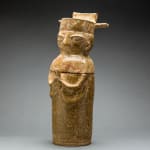Han Glazed Anthropomorphic Container, 206 BCE - 220 CE
Glazed Terracotta
43.8 x 18.4 cm
17 1/4 x 7 1/4 in
17 1/4 x 7 1/4 in
TF.038
Further images
The Han dynasty lasted for over four hundred years and is often credited with the unification of China. Han emperors certainly developed the centralising initiatives of the Qin, whose short...
The Han dynasty lasted for over four hundred years and is often credited with the unification of China. Han emperors certainly developed the centralising initiatives of the Qin, whose short but effective regime brought an end to years of civil war and unrest. The production of ceramics also under went a revolution during the Han era. This was partly due to the regulation of burial practice. It was customary, at least amongst the nobility, to bury the dead with the necessary equipment for the afterlife. During the Han dynasty, particularly during times of economic distress, restrictions were placed on the burial of precious materials such as gold, silver and jade. Funerary furnishings (known in Chinese as ‘mingqi’) made of earthenware proliferated as a result. Some were painted in bright colours after firing in the kiln, others, such as this object, were covered in a fine lead-glaze. The two main colours were green (made from copper oxide) and ochre (from iron oxide), which anticipated the Sancai-glazed wares of the Tang Dynasty. Clay figurines of people, including attendants, chefs, musicians, dancers and soldiers were buried to care for their master/mistress in the afterlife. Animals also feature prominently, especially horses, dogs and bulls.
This glazed container is exceptionally rare and intriguing. The lid of the vessel is in the form of the shoulders and head of a man. The figure wears a close-fitting hat with an inverted ‘t’ shape wedge affixed to the back. The hair and the small triangular beard have been indicated by rough incisions in the surface of the wet clay. The ears, nose and bulging eyes were added in relief. The figure’s arms are evident on the lower half of the container, also moulded in relief. A long, flat rectangular objects protrudes from the figure’s clasped hands. It is impossible to identify this with certainty, though it is probably some kind of ritual or votive object. Han pottery figurines are often depicted using the tools of their trade, such as chefs with a chopping board and knife or musicians with their instruments. Beneath the arms a second set of folds appear which may represent some kind of drapery. This sculpture reveals Han artistry at its finest, combining realism, such as the careful delineation of the fingers, with an attractive simplicity and abstraction. Despite minor restoration to the body of the vessel, the piece is in excellent condition and deserves to be the centrepiece of an ambitious collection of early Chinese pottery. (AM)
This glazed container is exceptionally rare and intriguing. The lid of the vessel is in the form of the shoulders and head of a man. The figure wears a close-fitting hat with an inverted ‘t’ shape wedge affixed to the back. The hair and the small triangular beard have been indicated by rough incisions in the surface of the wet clay. The ears, nose and bulging eyes were added in relief. The figure’s arms are evident on the lower half of the container, also moulded in relief. A long, flat rectangular objects protrudes from the figure’s clasped hands. It is impossible to identify this with certainty, though it is probably some kind of ritual or votive object. Han pottery figurines are often depicted using the tools of their trade, such as chefs with a chopping board and knife or musicians with their instruments. Beneath the arms a second set of folds appear which may represent some kind of drapery. This sculpture reveals Han artistry at its finest, combining realism, such as the careful delineation of the fingers, with an attractive simplicity and abstraction. Despite minor restoration to the body of the vessel, the piece is in excellent condition and deserves to be the centrepiece of an ambitious collection of early Chinese pottery. (AM)





